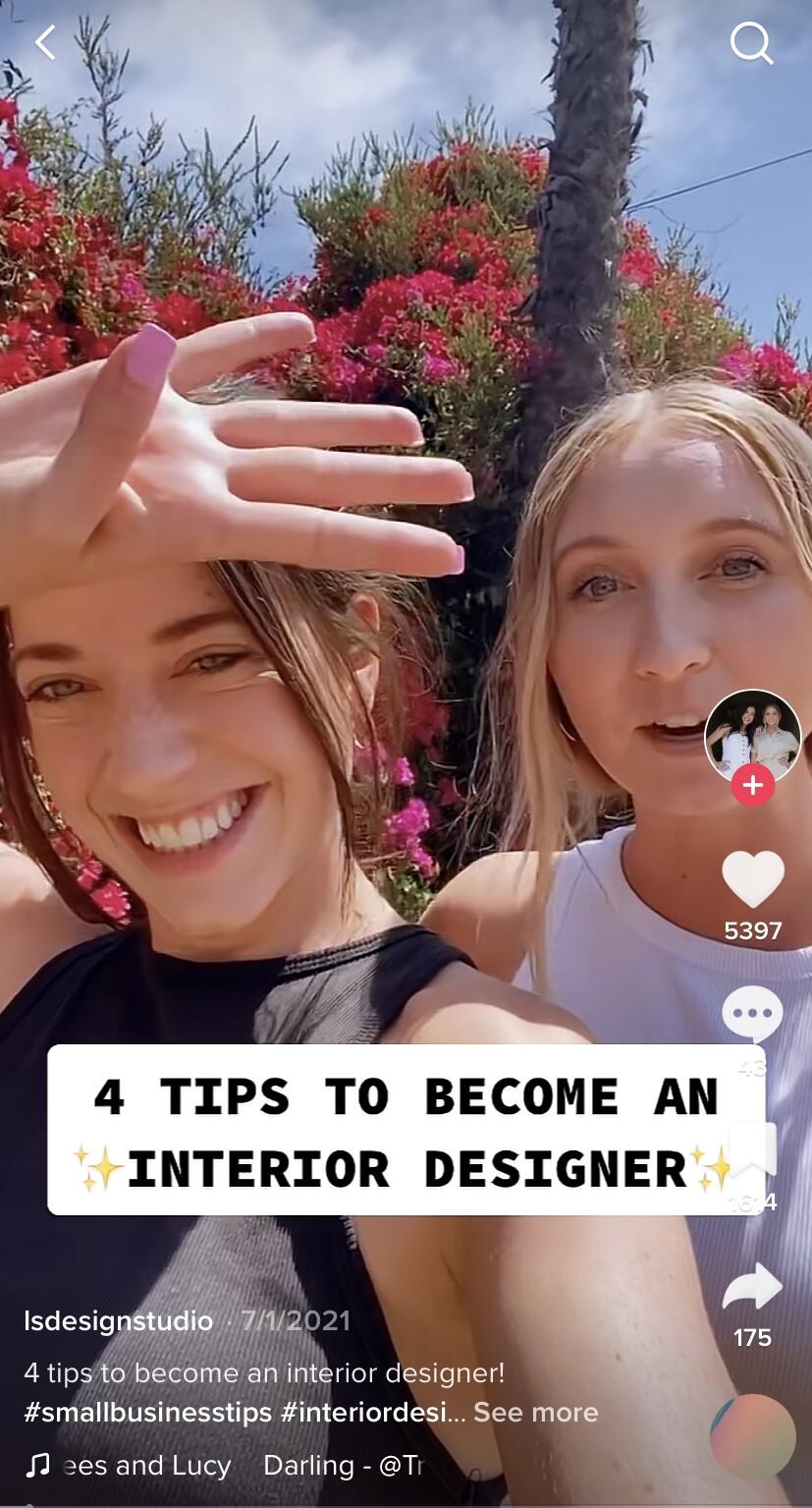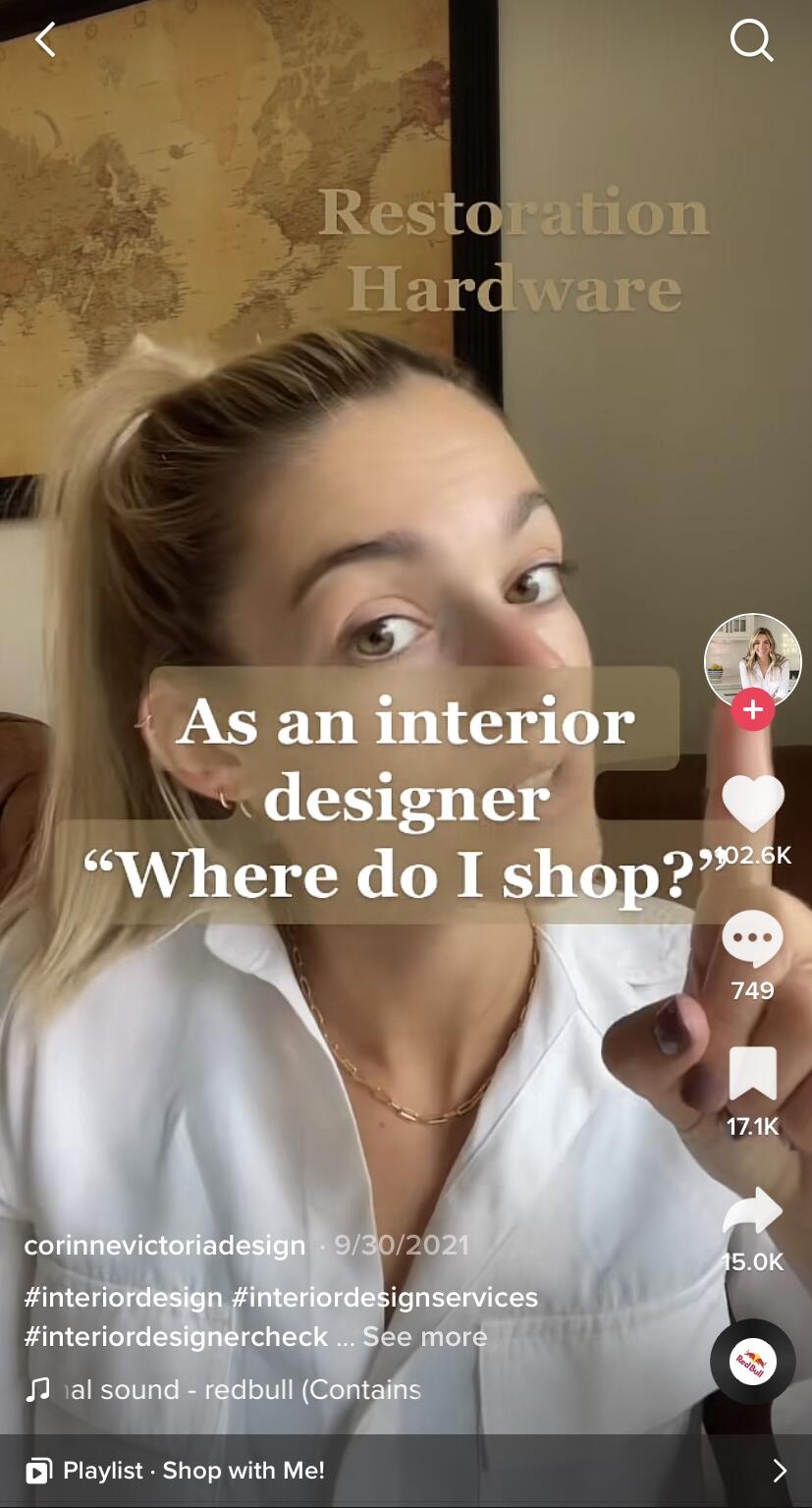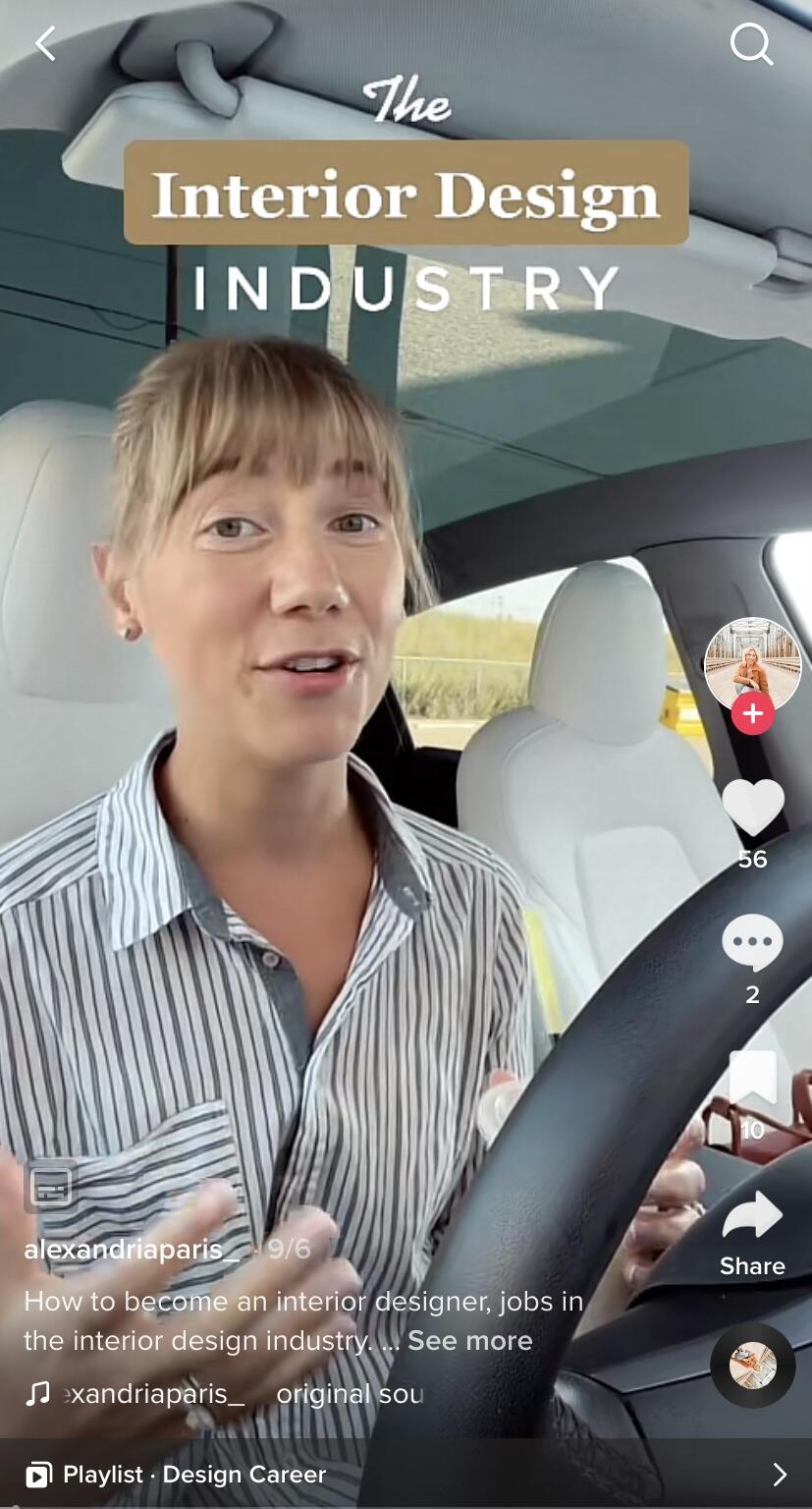For Lilli Morgan and Savannah Duren, co-founders of design firm LS Design Studio, social media has always been the bedrock. The pair first met six years ago as colleagues at a design firm in San Diego, where they’d both worked their way up from assistant to senior designer. During the peak of the pandemic, a yearning for greater creative freedom prompted the two to leave their jobs and start their own business amid the boom in requests for home design services. Their first stop? Instagram.
To get their budding firm off the ground, Morgan and Duren decided to focus on social media to nab their first clients and project an image of the business they aspired to be. Since the majority of their projects thus far had been low budget, they hired a rendering firm to create images of rooms displaying their aesthetic and posted those as a portfolio to give potential clients a sense of their style. On their next stop, TikTok, they were much less strategic—and somehow, much more successful.
“I remember when we posted our first TikTok, we didn’t even know how to work the app, and actually making a video was a whole other beast,” says Morgan. “Then I looked, and I was like, ‘Wait, this is kind of getting more views than we were expecting?’ It had like 25,000—and it was our very first TikTok.”

Today, Morgan and Duren’s most popular video to date is also something the pair didn’t expect to capture much attention: a bit titled, “4 Tips to Become an Interior Designer.” The 35-second clip features the pair speaking directly to the camera and outlining brief strategies for networking, education, building a portfolio and accessing design software programs. It’s racked up nearly 70,000 views and dozens of comments from users with follow-up questions.
As the pair would come to find, they’d stumbled upon a TikTok niche in high demand among the app’s design-focused users—a genre of informational videos centered on what it takes to enter the industry and how to operate a design business once you do. It’s a subject that’s certainly drawing eyes: the more focused terms #interiordesigncareer and #interiordesignbusiness have over 78,000 and 120,000 views on the app, respectively, while the big-picture hashtag #interiordesigner has 1.7 billion views. Altogether, home renovation and DIY is one of TikTok’s most popular categories, amassing 39 billion views total as of this year. As a result, designers willing to divulge a few industry secrets on the platform are being rocketed to sudden fame.
TikTok’s growing hold on the world’s attention can’t be underestimated. According to a report conducted by Business of Apps, the platform had 1.2 billion monthly active users last year, and is on track to hit 1.8 billion from more than 155 countries by the end of 2022. The app gets a staggering amount of facetime, with active users spending an average of 95 minutes on TikTok daily. More and more, the app is also becoming a key source of information for users: according to a new Pew Research Center study, 33 percent of TikTok users say they regularly get their news on the app—up from 22 percent in 2020.
The app’s quick form video format and unique recommendation algorithm tend to popularize a certain kind of video. Yes, that’s viral dances—but it’s education, too. Informational content, in which users share little-known tips or trick to navigating a certain area of expertise, performs well on TikTok in a way it never has on Instagram. For designers who have produced such content, including Morgan and Duren, that means not only more eyes on their videos, but also more interaction from users behind the screen.
It was one thing to go viral so quickly on the app, Morgan and Duren say—a phenomenon that many have experienced on the platform, which uses an algorithm to supply videos to a user’s main feed, rather than pulling strictly from those they follow. More unexpected was the fact that so many viewers reached out asking for advice and information about Morgan and Duren’s own professional journey. “I was surprised by how many people wanted to engage with us based on this one video,” says Duren.
Since both designers took different, but relatively common, routes into design (Duren earned her design degree, while Morgan entered the industry after studying communications and entrepreneurship in college) they felt well positioned to dish out design career guidance to their TikTok fans. Among the tips they offered was the idea that while going to design school can’t hurt your career, it isn’t always necessary. That stance, however, sparked a debate in the comments, with some established designers chiming in to draw a boundary between “interior decoration” and “interior design”—proving that long-running industry debates have made their way onto TikTok. It’s a conversation Morgan and Duren welcome, as long it helps educate the next generation of designers on their career options.
“When I was in college trying to decide my major, if I had seen videos of designers’ ’Day in the Life’ and stuff like that, I would have been sold for interior design as my major,” says Morgan. “It’s super helpful in letting people know this is a field you can be successful in.”

Toronto, Canada–based designer Kimberly Czornodolskyj feels the same way. She grew up in the pre-social media era, instead getting her impressions of design role models from HGTV, where the post-production polish made the whole profession seem unattainable. After working within firms for years, she launched her own business in April, and has maintained a presence on TikTok since 2021. On the app, Czornodolskyj has found that informative content (rather than solely image of well-designed spaces) performs well, especially when it comes to early career advice.
“When I post about being a designer, the number-one question [from users] is, ’I’ve been thinking of getting into this space, what can I do? How can I get into it?” she says.
Some users have even asked Czornodolskyj to share her guidance over a phone call or Zoom, which she has happily agreed to. Beyond helping others get into the profession, she’s also interested in pulling back the curtain to reveal more of the day-to-day aspects of design—even when they’re not as pretty as the final picture.
At 258,000 views, one of her biggest hits on TikTok started with a real-life design problem. It all began at a job site for one of her projects, when a stone installer ripped up a swath of brand-new wallpaper while placing a new countertop. The situation required a creative workaround—and instead of handling things behind the scenes, Czornodolskyj posed the dilemma and possible solutions in a video to her TikTok audience. While her followers flocked to the comments section to offer suggestions, many fellow designers also thanked her for exposing the problem-solving part of the job.
As Czornodolskyj sees it, users on Instagram are typically drawn to more polished images, while TikTok’s viewers, or maybe its algorithm, prize content that’s just the opposite—more casual, off-the-cuff and personal. The difference in tone is why she suspects everyone behaves differently on TikTok: Early-career designers feel comfortable interacting publicly with established designers; industry professionals engage in debate in the comments; and everyone shares more about the nitty-gritty details of their jobs.
Virginia designer Corinne Vassallo initially joined TikTok upon her younger brother’s suggestion, in hopes of increasing her own brand awareness—but the app’s tendency toward open, honest content has prompted her to shift her focus toward industry transparency. “I find that a lot of people are confused about how designers work, how much they cost and why they should be buying a $5,000 coffee table over what they see at Crate and Barrel,” says Vassalo. “So that was the next level of how I approached videos, trying to educate people on what designers do, what they sell and why.”
In her videos, Vassallo explains everything from the breakdown of her own design fees to why she doesn’t pass her trade discount to clients—an act of sharing she thought would conjure backlash from fellow designers in a traditionally hush-hush industry. Instead, she’s received praise from her peers in the industry, many of whom are eager to educate people on how professional design services actually work. In fact, the backlash she does receive for sharing insider details (like her favorite trade-only furniture brands) has come from everyday design enthusiasts.

Under one of Vassallo’s videos titled “As an interior designer, where do I shop?”, a user commented “Kinda mean to share stores the public can’t access.” Another echoed: “Why do you recommend brands that people can’t purchase without a designer?” Vassallo attributes this pushback to the popularity of DIY influencers, who have long dominated social platforms. Professional design services, she speculates, are often a whole new world to many online design fanatics.
Despite the occasional snarky comment, educating potential clients on the benefits of design services has paid off, as the app has served as a source of revenue for Vassallo. When she initially joined TikTok, she joked that because of the app’s young user base, her only leads for design projects would be redecorating dorm rooms. Instead, she’s had the opposite experience: Since joining TikTok, 90 percent of her new client inquiries (all within her target range of ages 35 to 55) initially found Vassallo on the app. Both Czornodolskyj and the duo from LS Design Studio have also seen an increase in new client leads coming in from TikTok, with several converting to real projects for both firms.
While all the designers agreed that they’ve been glad to adopt the role of design mentor on the app, they admit that enlightening the next generation wasn’t their original intent. After all, none are looking to set up a coaching business—but when setting out to increase their exposure, sharing industry resources has proved to be the best way to do so. It puts the creators in the somewhat strange position of educating the young design enthusiasts that may very well be their competition some day.
For Calgary, Canada–based designer Alexandria McKinley, whose services are entirely virtual, the app has introduced a new world of opportunities. McKinley’s e-design services are limited to providing clients with mood boards, feng shui energy charts and design shopping lists, and she’s almost never on-site to photograph the finished product. For those reasons, despite the online nature of her business, McKinley’s Instagram audience plateaued at around 2,000 followers for several years, as she had limited content to post.

TikTok has been another story. McKinley’s videos mainly consist of her talking directly to camera, offering advice on design-centric career options, along with general design and styling tips. The casual and informational approach played to McKinley’s natural strengths: Within her first three months on the app, her account surpassed 100,000 followers, and she’s now amassed an audience of more than 162,000. To monetize her new reach, she’s in the process of rolling out digital download products such as design guides and curated product lists.
Using her own journey as an example, McKinley suggests that aspiring designers who’ve yet to build an Instagram-worthy design portfolio use TikTok as a springboard for their careers. As she points out, the candor of talking directly to camera offers potential clients with a sense of a designer’s personality and demeanor that a portfolio or even an introductory phone call can’t always convey. “Getting to connect with a designer on a personal level and understand their opinions, and their approach to how to design or decorate a space, it opens up another level of connection,” says McKinley. “Once I switched over to TikTok, that really allowed people to put a face to my business and really get to know me almost on a personal level and get comfortable with me.”
Looking ahead, McKinley sees the platform as a harbinger of things to come for the design industry. While sharing information fosters the next generation of professionals, it also seems to be educating the next generation of design clients. Much like Instagram’s hyper-curated imagery came to dominate the online design world over the past decade, TikTok’s focus on transparency might set the tone in the years to come, creating a space where design education and commerce converge. Even if the app itself ultimately fades, the change it has wrought will be felt across the broader landscape of social media—YouTube and Instagram have both been pivoting in recent months to focus more on short-form video in an effort to, well, be more like TikTok.
“People are now rejecting that fully polished look of Instagram and Pinterest, and they’re looking to connect with brands and people on a more intimate, authentic level,” says McKinley. “I think there will come a day where potential clients are going to start aligning with designers that they can get to know on a personal level through their TikTok that you’re never really going to get fully through Instagram.”
Homepage image: Shutterstock




























